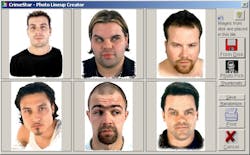When inmates are taken into custody, their every movement and activity must be tracked. This is an intricate process requiring a shareable, secure and accurate tracking method—the reason why most jail management today is automated.
This type of software has compelling advantages over manual or “home-brew” electronic methods: strengthened tracking of inmates and management of civil documents; higher safety against potential high-risk threats; faster processing of inmates through the courts. The upshot being increased productivity and time savings for jail personnel.
Safety a high priority
Among the most critical criteria for purchasing a software program is the ability to ensure security and safety at all times, especially when handling inmates. The Miller County Jail with a capacity for 341 inmates, and part of the Sheriff’s Office in Texarkana, Arkansas, considers an electronic jail management program essential for this task. According to Dr. Yates Morgan, a licensed clinical psychologist and administrator for the sheriff’s office, the maximum security jail has an area devoted to high level security and one for detainees deemed not to be a serious risk. When Dr. Morgan came aboard in 2011, his job was to build a system that could evaluate where inmates would live based on their level of risk—a category known as classification and one which most jail management software programs address. A comprehensive records management program from Crimestar Corp. was in place, with a classification function built into the software’s jail management module.
“The classification feature allows us to determine what level of risk a particular detainee may present to us,” says Morgan. Detainee information is obtained from criminal background information provided by the National Crime Information Center (NCIC) as well as from the Arkansas Crime Information Center. These databases provide Miller County Sheriff’s Office with a scan of a detainee’s criminal background that is placed into the Crimestar software classification module.
Information sharing
Hamstrung by a constraining manual records management program with persistent software bugs and no technical support, the Houston County Sheriff’s Office in Crockett, Texas, turned to a completely electronic program in 2011 that allowed tighter coordination and tracking of jail operations. What appealed to the sheriff’s office is that the software’s modules could be purchased individually.
“We bought the jail management and RMS modules so that all the officers could build their cases, as well as a CAD module, so that when any call comes in the dispatcher generates a case number for the RMS,” say Susie Hammond, dispatch supervisor and crime analyst.
A civil module for civil process serving also was purchased. “What’s beneficial about buying all of these programs is that if I put someone in the jail and I do a name search in the CAD, I see that this person has perhaps been in jail,” says Hammond. “If I’m an officer doing a report and have a suspect and do a name search, I may also find that this person was in jail.”
This Dynamic Name Association feature, contained within the eFORCE Software suite of RMS, CAD, and Jail modules that the sheriff’s office purchased, is central to the software’s utility. “We get a true snapshot of that person when his record comes up and how we’ve handled him—through jail, RMS, or dispatch,” says Hammond. Photos of a suspect or incarcerated individual can also be attached to his record in the electronic report.
Software as ‘operational support tool’
Jail management software enables key tasks to be performed more quickly, with easy searches and sharing of information by multiple users. Cory Bowers, CEO of eFORCE Software, believes the needs of jails and corrections facilities are very common across the board. “The real separator is the liability, especially for a larger agency, and the needs for reporting, such as specialized reports for each state,” Bowers says.
Another boon for automation is web-based solutions offering user access to jail related data via iPads and cellphones from different locations. Integration of RMS, CAD, civil processing and jail management is also gaining momentum. eForce’s customers can buy modules separately, but often choose the software’s entire suite to allow constant cross-referencing of inmate backgrounds and activity status. In this way, Bowers says, “We give customers an operational support tool.”
Information access must be restricted
When the Benton County, Oregon, Sheriff’s Office sought a more advanced program to replace its older software system that stymied tracking and updating of its jail operations, the main criterion was ironclad security of information. As with most software programs, data on inmates is stored on a server, not individual computers, and within an SQL database. According to Kenny Horne, vice-president of sales and marketing for Beacon Software Solutions Inc., multiple security roles are set up in the software, allowing authorized personnel to manipulate data, delete records, add drop-down menus, book and photograph arrestees, along with other tasks. “Benton County Jail logs everything,” says Horne, which requires users to enter an ID number with username and password each time. Horne says everything is dated and time-stamped from the server.
Accountability a main goal
For Diana Rabago, Benton County Jail commander, these security measures boost accountability—the high-water mark of any jail software program. Using the software, Rabago can formulate questions around a certain time indicated for an activity for a specific inmate. She can also see dates and times when personnel entered activities into the software. Rabago also values the historical data stored within the software program, noting that “[she] can find information on inmates from eight months ago and find it fast.”
The benefits for Benton County’s new jail management software are increased productivity and accuracy, especially for documentation.
Multiple counties adopt same software for maximum efficiency
Collin County, Texas, Sheriff’s Office is one of 15 other counties that collectively selected a comprehensive justice management software program by Tyler Technologies. This gave the counties access to Tyler’s full suite of modules. The jail module was not fully developed in 2005 when the entire suite was adopted. Thus, Collin County worked with Tyler to build a customized feature for tracking every movement of its 916 inmates—at the time a major feat, yet highly successful.
Civil processing, once notoriously slow, is now speedy with the new software. Consider an arrest warrant that once took nearly a day to arrive. Now the county’s jail case coordinator Tonya Smith receives warrants in real time after the judge signs them.
Other tasks for jail management oftentimes took days, such as a statistics report that breaks down each inmate by classification, number of inmates in jail, and their status. Thanks to automation that report is generated every day.
Building statistics, crime mapping aid crime analysis
While jail management solutions are found in fully integrated RMS software and standalone programs, integration gives stronger advantages. RMS will include records of incident reports and inmate tracking, and provide a criminal history on arrestees.
The RMS can manage years of data originating from crime events in the community to jail operations. For instance, Crimestar software enables data manipulations that focus on numerous crime features like suspect profiling. Dr. Morgan says, “We’re able to display and feature this data so we can build a profile of likely suspects, where those suspects may be located, and where they are likely to commit their next crime.” This type of information is crucial once the suspect ultimately is caught and booked into jail given the behavioral perspective built through the software.
Potential for liability looms
According to Alec Gagne, president of RMS software provider Crimestar, when an agency buys just one module for a specific task “they don’t know what they don’t know about other information (on a suspect or inmate) that could be useful. If your law enforcement agency uses integrated RMS software and an arrestee is brought in, you now have the ability to do multiple searches on his criminal background.”
When a jail has physical custody of somebody against his will, this is a huge responsibility. If something happened to them while in custody, such as injury, death or mistreatment, this situation could trigger lawsuits. “The more information you have about people being brought into your jail, the better equipped you are to provide the environment of safety to help isolate you from potential liability,” Gagne says.
Crime mapping, analysis aids inmate risk detection
Tracking, key for any jail management software, enables jail personnel to focus on detainees who are admitted to the jail and have a particular risk feature that requires close tracking. “Let’s say we have some admissions to our jail that are gang involved,” says Dr. Morgan. “We want to know who they are, where they are. We might need more information about the gang they’re affiliated with. The tracking module allows us to keep up with certain groups that create special risks.”
Crime mapping, as part of an integrated RMS program, can aid jail management significantly. It provides important information to administrators and field supervisors about what’s going on with crime in certain areas of a jurisdiction.
Jail a ‘community’
As jails confront fluctuating inmate populations, they must have a reliable jail management system, which automation provides. Electronic solutions yield smoother and tighter coordination of inmate activities, records information tracking and sharing, and higher security controls with records. Automated activities such as victim notification, tracking of inmates, civil processing, admission and release of inmates, and inmate health records monitoring ensure accountability and accuracy. The benefits are advanced and dependable functionality, simplifying processes, boosting efficiency, and improving a jail’s workflow.
For Dr. Morgan, jail management software “is not a program to manage a prison, but one to manage law enforcement efforts in the community. So, you have to kind of envision the jail as being a community entity as opposed to a prison.” ■
Robert Galvin is an Oregon City, Oregon-based freelance writer who writes about law enforcement technology tools and software. He has written extensively about records management software and, in particular, jail management software solutions. He can be reached at: [email protected].



